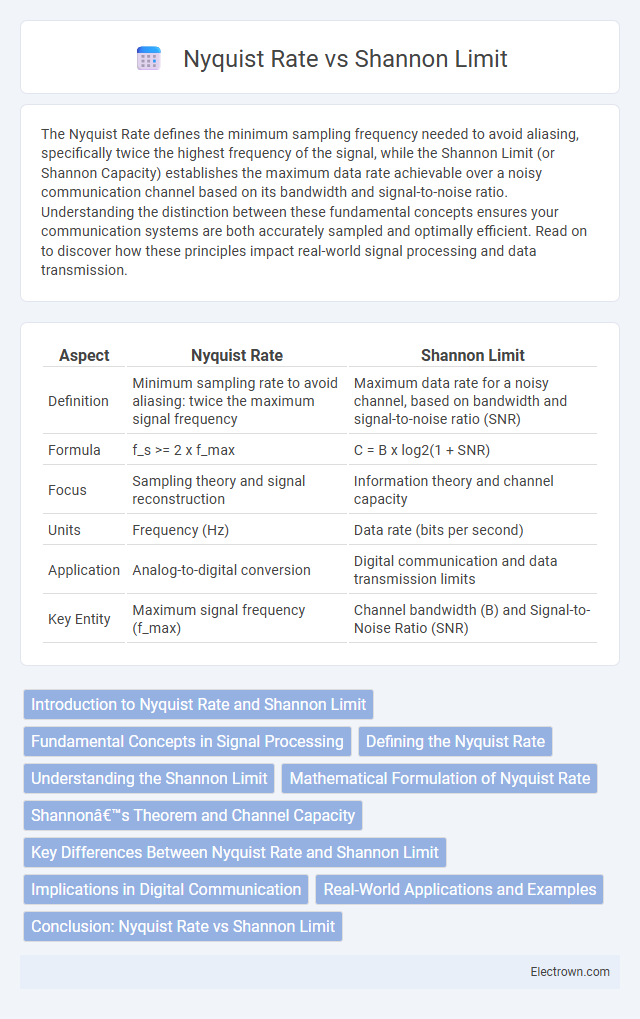The Nyquist Rate defines the minimum sampling frequency needed to avoid aliasing, specifically twice the highest frequency of the signal, while the Shannon Limit (or Shannon Capacity) establishes the maximum data rate achievable over a noisy communication channel based on its bandwidth and signal-to-noise ratio. Understanding the distinction between these fundamental concepts ensures your communication systems are both accurately sampled and optimally efficient. Read on to discover how these principles impact real-world signal processing and data transmission.
Table of Comparison
| Aspect | Nyquist Rate | Shannon Limit |
|---|---|---|
| Definition | Minimum sampling rate to avoid aliasing: twice the maximum signal frequency | Maximum data rate for a noisy channel, based on bandwidth and signal-to-noise ratio (SNR) |
| Formula | f_s >= 2 x f_max | C = B x log2(1 + SNR) |
| Focus | Sampling theory and signal reconstruction | Information theory and channel capacity |
| Units | Frequency (Hz) | Data rate (bits per second) |
| Application | Analog-to-digital conversion | Digital communication and data transmission limits |
| Key Entity | Maximum signal frequency (f_max) | Channel bandwidth (B) and Signal-to-Noise Ratio (SNR) |
Introduction to Nyquist Rate and Shannon Limit
The Nyquist Rate defines the minimum sampling frequency required to accurately capture a signal without aliasing, equal to twice the highest frequency component of the signal. The Shannon Limit, or Shannon Capacity, establishes the theoretical maximum data transmission rate of a communication channel based on its bandwidth and signal-to-noise ratio, as dictated by the Shannon-Hartley theorem. Both concepts are fundamental in digital signal processing and telecommunications for optimizing signal sampling and channel capacity.
Fundamental Concepts in Signal Processing
The Nyquist Rate defines the minimum sampling frequency required to accurately capture a continuous signal without aliasing, which is twice the highest frequency component of that signal. The Shannon Limit, or Shannon Capacity, represents the maximum achievable data transmission rate over a noisy channel, dictated by the channel bandwidth and signal-to-noise ratio according to Shannon's theorem. Understanding these fundamental concepts in signal processing enables you to design systems that balance sampling accuracy and data transmission efficiency within communication constraints.
Defining the Nyquist Rate
The Nyquist Rate defines the minimum sampling frequency required to accurately capture a continuous signal without aliasing, set at twice the highest frequency component present in the signal. It ensures signal reconstruction fidelity by preventing overlap in the frequency domain during sampling. This principle underpins digital signal processing, distinguishing it from the Shannon Limit which addresses channel capacity and noise.
Understanding the Shannon Limit
The Shannon Limit defines the maximum data transmission rate over a noisy communication channel without error, determined by the channel bandwidth and signal-to-noise ratio. It establishes the theoretical upper bound for reliable communication, beyond which data errors become inevitable despite increased power or coding. This principle guides the design of efficient coding schemes to approach error-free transmission near the Nyquist rate, optimizing bandwidth utilization.
Mathematical Formulation of Nyquist Rate
The Nyquist Rate is mathematically defined as twice the highest frequency component (f_max) of a signal, expressed as Nyquist Rate = 2 * f_max, which determines the minimum sampling rate to avoid aliasing. This contrasts with the Shannon Limit, which defines the maximum channel capacity (C) as C = B * log2(1 + SNR), where B is bandwidth and SNR is signal-to-noise ratio. Understanding the Nyquist Rate helps you sample signals efficiently while maintaining data integrity in digital communication systems.
Shannon’s Theorem and Channel Capacity
Shannon's Theorem establishes the maximum data rate, or channel capacity, that can be achieved over a communication channel without error, given its bandwidth and signal-to-noise ratio. The Nyquist Rate determines the minimum sampling frequency needed to accurately reconstruct a signal without aliasing, but it does not account for noise constraints addressed by Shannon's limit. Understanding these principles helps optimize Your data transmission by balancing sampling frequency and channel capacity for efficient and reliable communication.
Key Differences Between Nyquist Rate and Shannon Limit
The Nyquist Rate defines the minimum sampling frequency needed to avoid aliasing, based on the bandwidth of a signal, typically twice the highest frequency component. The Shannon Limit, rooted in the Shannon-Hartley theorem, establishes the maximum data transmission rate of a channel for a given bandwidth and signal-to-noise ratio, representing the theoretical capacity boundary. Understanding these key differences helps you optimize communication systems by balancing sampling accuracy with channel capacity constraints.
Implications in Digital Communication
The Nyquist Rate defines the minimum sampling rate required to accurately capture a signal without aliasing, which is essential for preserving data integrity in digital communication systems. The Shannon Limit, representing the maximum channel capacity for error-free transmission at a given noise level, sets fundamental bounds on achievable data rates and influences coding and modulation strategies. Together, these principles guide the design of efficient digital communication systems by balancing sampling frequency and bandwidth constraints with noise resilience.
Real-World Applications and Examples
The Nyquist Rate determines the minimum sampling frequency required to accurately capture a signal without aliasing, playing a critical role in digital audio recording and telecommunications where signals must be digitized precisely. The Shannon Limit, or Shannon Capacity, defines the maximum data transmission rate over a communication channel given its bandwidth and noise level, guiding the design of high-efficiency wireless networks and error-correcting codes in data storage. Practical systems like 4G LTE and fiber-optic communications leverage these principles to optimize bandwidth usage and ensure reliable, high-speed data transfer.
Conclusion: Nyquist Rate vs Shannon Limit
The Nyquist Rate defines the minimum sampling frequency required to avoid aliasing for a given bandwidth, typically twice the highest frequency component. The Shannon Limit, or Shannon Capacity, establishes the maximum achievable data transmission rate over a noisy channel based on bandwidth and signal-to-noise ratio. In conclusion, while the Nyquist Rate addresses sampling requirements, the Shannon Limit sets the theoretical upper bound on reliable communication rate, making both fundamental but distinct concepts in information theory and signal processing.
Nyquist Rate vs Shannon Limit Infographic

 electrown.com
electrown.com